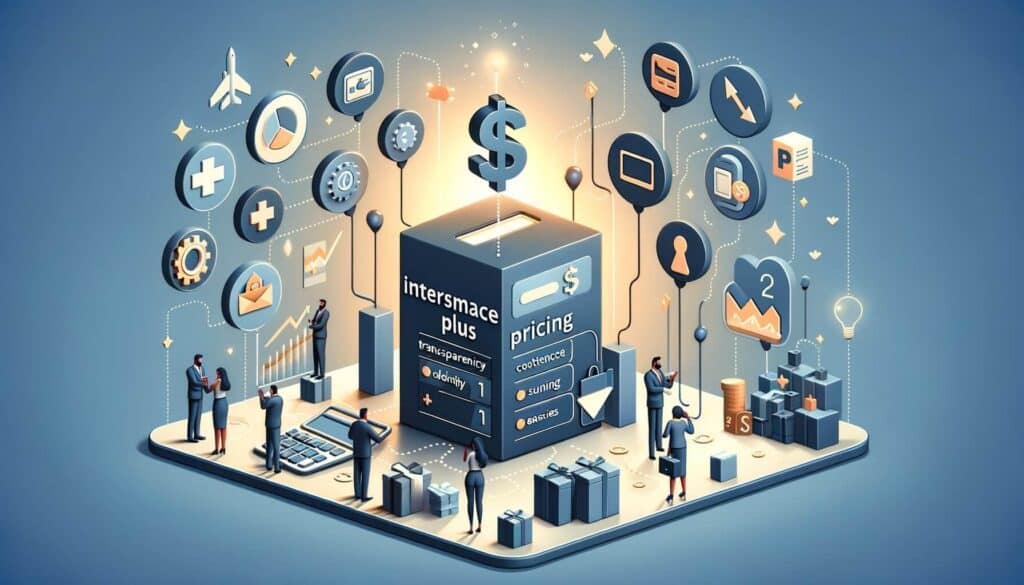
By Barbara Thomas March 11, 2025
Interchange Plus Pricing is a payment processing model that has gained popularity among businesses in recent years. It offers transparency and cost-effectiveness, making it an attractive option for merchants.
In this article, we will delve into the details of Interchange Plus Pricing, exploring its basics, benefits, working mechanism, factors affecting pricing rates, comparisons with other pricing models, choosing the right payment processor, common misconceptions, and frequently asked questions.
Understanding the Basics of Interchange Plus Pricing
Interchange Plus Pricing is a pricing model used by payment processors to determine the fees charged to merchants for processing credit and debit card transactions. It consists of two components: interchange fees and a markup fee. Interchange fees are set by card networks like Visa and Mastercard and are non-negotiable. They are the fees paid by the merchant’s bank to the cardholder’s bank for each transaction. The markup fee, on the other hand, is the profit margin charged by the payment processor.
The key difference between Interchange Plus Pricing and other pricing models, such as tiered or flat-rate pricing, is the transparency it offers. With Interchange Plus Pricing, merchants can see the exact interchange fees charged by the card networks, allowing them to understand the true cost of each transaction. This transparency enables businesses to make informed decisions and negotiate better rates with payment processors.
Benefits of Interchange Plus Pricing for Businesses

Interchange Plus Pricing offers several benefits for businesses, making it a preferred choice for many merchants. Firstly, it provides transparency, allowing merchants to see the actual interchange fees charged by the card networks. This transparency helps businesses understand their costs and identify areas for potential savings.
Secondly, Interchange Plus Pricing offers cost-effectiveness. Since the markup fee is separate from the interchange fees, merchants can negotiate the markup fee with the payment processor. This negotiation power enables businesses to secure competitive rates and reduce their overall payment processing costs.
Furthermore, Interchange Plus Pricing is fair and equitable. Unlike tiered pricing models, where transactions are categorized into different tiers with varying rates, Interchange Plus Pricing ensures that merchants pay the same markup fee for each transaction. This eliminates the risk of hidden fees or unexpected charges.
How Interchange Plus Pricing Works in the Payment Processing Industry

In the payment processing industry, Interchange Plus Pricing works by combining the interchange fees set by the card networks with the markup fee charged by the payment processor. When a customer makes a credit or debit card payment, the transaction is processed through the payment processor, who deducts the interchange fees and the markup fee before depositing the remaining amount into the merchant’s account.
The interchange fees are determined by various factors, including the type of card used (credit or debit), the card brand (Visa, Mastercard, etc.), the transaction type (in-person, online, etc.), and the risk associated with the transaction. These fees are standardized and non-negotiable, ensuring a level playing field for all merchants.
The markup fee, on the other hand, is negotiable and varies between payment processors. It is typically a percentage of the transaction amount or a flat fee per transaction. Merchants can negotiate this fee with the payment processor to secure competitive rates.
Factors Affecting Interchange Plus Pricing Rates

Several factors influence the interchange fees and markup fees in Interchange Plus Pricing. Understanding these factors can help merchants negotiate better rates and optimize their payment processing costs.
1. Card Type: Different card types, such as credit or debit cards, have varying interchange fees. Credit cards generally have higher interchange fees due to the additional risk associated with lending money to cardholders.
2. Card Brand: Each card brand, such as Visa, Mastercard, or American Express, has its own interchange fee structure. These fees can vary based on the brand’s policies and the benefits offered to cardholders.
3. Transaction Type: The method of transaction, whether it is in-person, online, or through a mobile device, can impact the interchange fees. Online and mobile transactions often have higher interchange fees due to the increased risk of fraud.
4. Risk Level: Transactions with a higher risk of chargebacks or fraud, such as those involving high-value purchases or international transactions, may attract higher interchange fees. Merchants can mitigate this risk by implementing fraud prevention measures.
5. Merchant Category: Some industries, such as travel or hospitality, may have specific interchange fee categories due to the unique nature of their business. Merchants operating in these industries should be aware of the specific interchange fees applicable to their category.
Comparing Interchange Plus Pricing with Other Pricing Models

Interchange Plus Pricing stands out from other pricing models, such as tiered or flat-rate pricing, due to its transparency and cost-effectiveness. Let’s compare Interchange Plus Pricing with these models to understand the advantages it offers.
1. Tiered Pricing: Tiered pricing categorizes transactions into different tiers, each with its own rate. While this model may seem simple, it often lacks transparency, as merchants are not aware of the interchange fees associated with each transaction. This lack of transparency can lead to higher costs for businesses. In contrast, Interchange Plus Pricing provides transparency by separating interchange fees and markup fees, enabling merchants to understand their costs and negotiate better rates.
2. Flat-Rate Pricing: Flat-rate pricing charges a fixed percentage or fee for all transactions, regardless of the interchange fees. While this model offers simplicity, it may not be cost-effective for businesses processing a high volume of transactions or those with higher average transaction values. Interchange Plus Pricing, on the other hand, allows businesses to pay the actual interchange fees set by the card networks, resulting in potential cost savings.
Choosing the Right Payment Processor for Interchange Plus Pricing
When opting for Interchange Plus Pricing, choosing the right payment processor is crucial. Here are some factors to consider when selecting a payment processor:
1. Pricing Structure: Ensure that the payment processor offers Interchange Plus Pricing and provides transparent pricing information. Look for processors that clearly outline their interchange fees and markup fees.
2. Negotiation Power: Assess the payment processor’s willingness to negotiate the markup fee. Some processors may be more flexible than others, allowing you to secure competitive rates.
3. Integration and Support: Consider the payment processor’s compatibility with your existing systems and the level of technical support they offer. Seamless integration and reliable support are essential for smooth payment processing operations.
4. Reputation and Security: Research the payment processor’s reputation in the industry and their track record in terms of security and fraud prevention. Look for processors that comply with industry standards and offer robust security measures.
Common Misconceptions about Interchange Plus Pricing
Despite its benefits, there are some common misconceptions about Interchange Plus Pricing. Let’s address these misconceptions to provide a clearer understanding of this pricing model.
1. Interchange Fees are Negotiable: Interchange fees, which are set by the card networks, are non-negotiable. Merchants cannot negotiate these fees directly with the payment processor. However, they can negotiate the markup fee, which is the profit margin charged by the payment processor.
2. Interchange Plus Pricing is Expensive: While Interchange Plus Pricing may seem complex, it can actually be cost-effective for businesses. By understanding the interchange fees and negotiating the markup fee, merchants can secure competitive rates and potentially reduce their payment processing costs.
3. Interchange Plus Pricing is Only for Large Businesses: Interchange Plus Pricing is suitable for businesses of all sizes. In fact, small and medium-sized businesses can benefit greatly from the transparency and cost-effectiveness it offers. It allows them to understand their costs and make informed decisions to optimize their payment processing expenses.
Frequently Asked Questions about Interchange Plus Pricing
Q1. What is the difference between interchange fees and markup fees in Interchange Plus Pricing?
Answer: Interchange fees are set by the card networks and are non-negotiable. They are the fees paid by the merchant’s bank to the cardholder’s bank for each transaction. Markup fees, on the other hand, are the profit margin charged by the payment processor and are negotiable.
Q2. Can merchants negotiate interchange fees in Interchange Plus Pricing?
Answer: No, interchange fees are standardized and non-negotiable. Merchants cannot negotiate these fees directly with the payment processor. However, they can negotiate the markup fee, which is the profit margin charged by the payment processor.
Q3. How can merchants reduce their payment processing costs with Interchange Plus Pricing?
Answer: Merchants can reduce their payment processing costs with Interchange Plus Pricing by negotiating the markup fee with the payment processor. By securing competitive rates, businesses can lower their overall expenses.
Q4. Is Interchange Plus Pricing suitable for small businesses?
Answer: Yes, Interchange Plus Pricing is suitable for businesses of all sizes. Small businesses can benefit from the transparency and cost-effectiveness it offers, allowing them to understand their costs and make informed decisions to optimize their payment processing expenses.
Conclusion
Interchange Plus Pricing is a transparent and cost-effective payment processing model that offers several benefits for businesses. By separating interchange fees and markup fees, it provides transparency and enables merchants to understand their costs. This transparency allows businesses to negotiate better rates and reduce their payment processing expenses. Interchange Plus Pricing is suitable for businesses of all sizes and can be a valuable tool for optimizing payment processing costs.
By understanding the basics, benefits, working mechanism, factors affecting pricing rates, comparisons with other pricing models, choosing the right payment processor, common misconceptions, and frequently asked questions, merchants can make informed decisions and leverage Interchange Plus Pricing to their advantage.